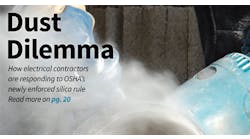To keep cables attached during a cable pull, you join the cable to the pulling lead using a knot. You wrap tape around the knot to "smooth out" the joint so it slides more easily through the raceway.
The tape isn't intended to hold the joint together. Wrapping excess tape around the joint to "make up for" a poor knot is a mistake. As the diameter of the splice grows, so does the force required to pull it through the raceway. This joint isn't nearly as flexible as the joined cable and pulling lead, so it's the binding point of the entire pull.
You want to keep this joint as small as possible but strong enough that it won't pull apart. How can you achieve this?
First, tie an eye knot in the rope (you can find videos online if you need to see how). Then, select an appropriate cable clamping device (e.g., pull sock); see what your electrical distributor offers. Next, attach the cable clamping device to the rope. Pull or twist to reduce diameter. About two knot's width ahead of the cable clamping device (opinion varies as to the ideal distance), start wrapping the pull lead half-lap style. Wrap down past the joint for two knot's width.


